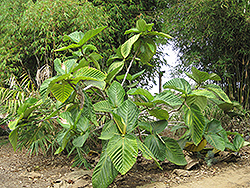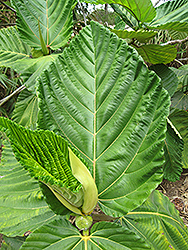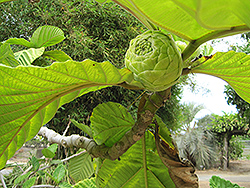Fri & Sat 8am - 8pm
Sun 8am - 7pm
Anytown, USA 12345
fax: 261.787.0463
e-mail: info@successgc.com


Plant Finder

Height: 30 feet
Spread: 30 feet
Sunlight:
![]()
![]()
Hardiness Zone: 10a
Other Names: Kapiak, Highland Breadfruit
Description:
An ornamental accent plant in warm climates featuring enormous, pleated, glossy green leaves; in frost free areas this variety can grow quite large, however it can be maintained as a houseplant; fruits are edible, but rarely eaten
Ornamental Features
Dinner Plate Fig is primarily grown for its highly ornamental fruit. The fruits are showy chartreuse pomes carried in abundance from mid summer to mid fall. The fruit can be messy if allowed to drop on the lawn or walkways, and may require occasional clean-up. It has attractive dark green foliage with creamy white veins. The enormous textured oval leaves are highly ornamental and remain dark green throughout the winter.
Landscape Attributes
Dinner Plate Fig is a multi-stemmed evergreen tree with an upright spreading habit of growth. Its strikingly bold and coarse texture can be very effective in a balanced landscape composition.
This tree will require occasional maintenance and upkeep, and is best pruned in late winter once the threat of extreme cold has passed. It is a good choice for attracting birds to your yard, but is not particularly attractive to deer who tend to leave it alone in favor of tastier treats. It has no significant negative characteristics.
Dinner Plate Fig is recommended for the following landscape applications;
- Accent
- Shade
- Hedges/Screening
- General Garden Use
- Container Planting
Planting & Growing
Dinner Plate Fig will grow to be about 30 feet tall at maturity, with a spread of 30 feet. It has a low canopy with a typical clearance of 1 foot from the ground, and is suitable for planting under power lines. It grows at a medium rate, and under ideal conditions can be expected to live for 50 years or more.
This tree does best in full sun to partial shade. It does best in average to evenly moist conditions, but will not tolerate standing water. This plant should not require much in the way of fertilizing once established, although it may appreciate a shot of general-purpose fertilizer from time to time early in the growing season. It is not particular as to soil pH, but grows best in rich soils. It is somewhat tolerant of urban pollution. Consider applying a thick mulch around the root zone in winter to protect it in exposed locations or colder microclimates. This species is not originally from North America.
Dinner Plate Fig is a fine choice for the yard, but it is also a good selection for planting in outdoor pots and containers. Its large size and upright habit of growth lend it for use as a solitary accent, or in a composition surrounded by smaller plants around the base and those that spill over the edges. It is even sizeable enough that it can be grown alone in a suitable container. Note that when grown in a container, it may not perform exactly as indicated on the tag - this is to be expected. Also note that when growing plants in outdoor containers and baskets, they may require more frequent waterings than they would in the yard or garden.


